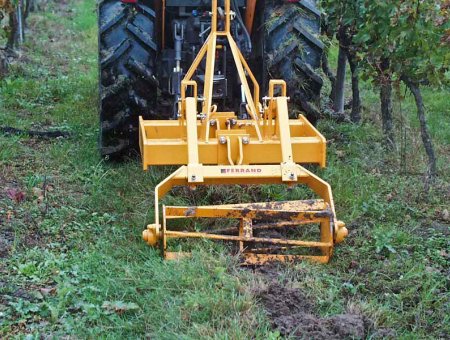Vineyard roller
Chopping rollers, such as the Rolofaca, lay down and pinch the plant cover to limit its development and encourage decomposition into mulch. They are often made by hand and are also used to level the soil after tine or disc tools. Made up of a steel frame, cast-iron bearings and different types of roller, these rollers are adjusted by their weight or a hydraulic cylinder. Their main function is to reduce weed growth and limit evaporation.

Work objective

Chopping rollers (Rolofaca type) lay down the plant cover to limit its development.
The Rolofaca chopping roller is a smaller version of the Landes roller used for forestry brush clearance.
To be effective, it needs to be fairly heavy (at Viti Méca, the load is transferred from the tractor by a hydraulic jack)
This type of roller, which is often home-made, is also used to level the ground behind a tine or disc tool.
The Rolofaca chopping roller is a smaller version of the Landes roller used for forestry brush clearance.
To be effective, it needs to be fairly heavy (at Viti Méca, the load is transferred from the tractor by a hydraulic jack)
This type of roller, which is often home-made, is also used to level the ground behind a tine or disc tool.
Components of the Rolofaca type chopping roller
The frame
Made of welded steel, the chassis provides the link between the tractor and the chopping rollers. It must be sufficiently heavy.The bearings
The bearings are made of cast iron and fitted with conical or ball bearings.The different rollers
The cage roller
The cage roller, used in conjunction with a toothed tool, limits the working depth of the tool it is fitted to.It is made up of metal bars welded to flanges, in line with the axis of rotation of the roller. Its main role is to limit the working depth of the driven tools with which it is often associated. It can also help to compact the soil after grass has been sown.
The Cultipacker roller
The growing interest in weed control techniques has led to the return of wedge ring rollers (packer rollers), which level out the soil and compact it during sowing.Made up of two rows of alternating rollers, formed by juxtaposing basic elements in a circular wedge shape, it crushes the clods of earth and compacts the soil, creating small furrows. Used in conjunction with a forage seed drill, it can be an excellent tool for grassing vines, as it is simple, robust and inexpensive.
The pneumatic roller
The pneumatic roller provides excellent consolidation. It is versatile, as it can be used for transport or as a depth control roller. It should not be used on loamy soils with a tendency to slope.The Cambridge roller
The Cambridge roller is made up of discs of different diameters. The discs are alternately smooth or pointed. The Cambridge roller works in a similar way to the Crosskill roller.The Crosskill roller
Crosskill rollers are made up of metal discs mounted on a shaft. They weigh between 150 and 540 kg per metre of working width. The periphery of these discs is covered with uneven radial and lateral protuberances. Their shape, number and arrangement are variable and depend on the purpose for which they are used. Every other disc is smaller in diameter and rotates at different speeds. The large discs rotate fairly freely around the support shaft and move slightly vertically and longitudinally, which helps to crumble the clods between the discs. They are best used on cloddy soil. They are not recommended for soils that are already well crumbled, as they leave too much fine soil. Crosskillettes rollers are made up of two Crosskills rollers of smaller than standard diameter and weight, assembled on the same frame. This tool is recommended for finishing off seedbed preparation because, at 120 to 270 kg/m , they are moderately energetic.The spiral roller
The spiral roller consists of a spiral wound around a shaft. With a diameter of between 450 mm and 600 mm, it provides good levelling and reconsolidation. Depending on the pitch of the spiral, it can be relatively susceptible to clogging in wet conditions on clay plots.Adjusting and using the roller
Setting
Depending on the design of the tool, there are few or no adjustments.Ground pressure depends on :
- the weight of the tool
- or (with Viti Méca) a load transfer from the tractor using a hydraulic cylinder
Use
The purpose of the roller is to :- lay down the grass
- pinch the stems to interrupt the sap supply to the upper aerial part. Vegetation growth is interrupted and the flattened cover acts as a mulch, preventing other grasses from growing.
- it also helps to limit evaporation.












